Spring’19 UTDesign CS Expo Showcases Cutting-Edge Senior Capstone Projects
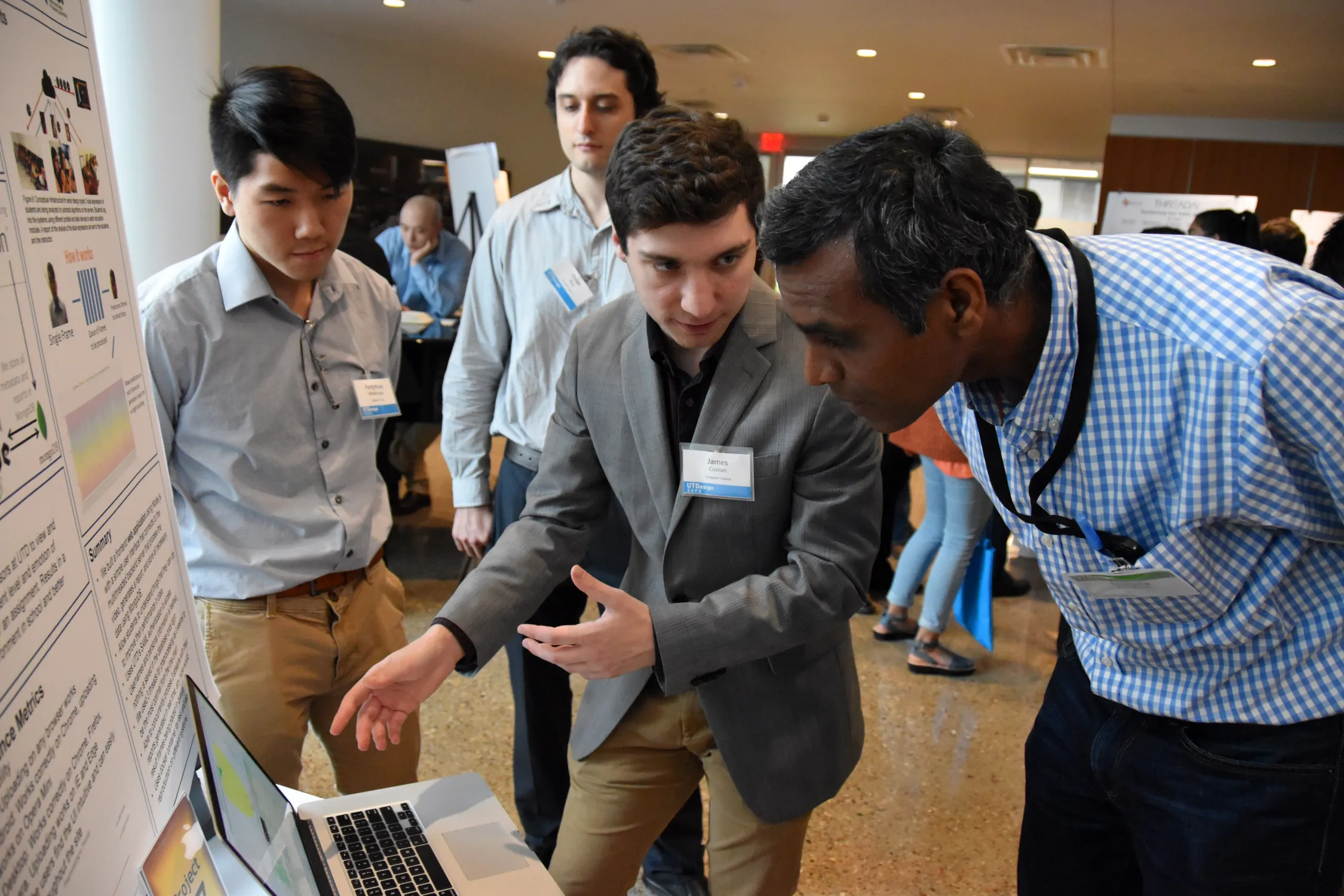
UT Dallas Computer Science and Software Engineering seniors came together last May to present their capstone projects at the Spring 2019 UTDesign Computer Science Expo. Fifty-two teams ranging from three to five members each presented their final projects to a room full of their peers, UT Dallas faculty members, and industry professionals. These final projects are intended to afford students the opportunity to apply concepts they have learned in past courses, to engage in a full-scale design process, as well as to practice their project-management and problem-solving skills. Under the UTDesign program, these capstone projects are proposed by industry and expose students to real-world problems, and in the process, the students gain industry experience and also learn new technologies that are actively used in the workplace. As an ancillary benefit, through working with and presenting to industry representatives, students have the opportunity for internships as well as potentially being recruited for employment by company sponsors.
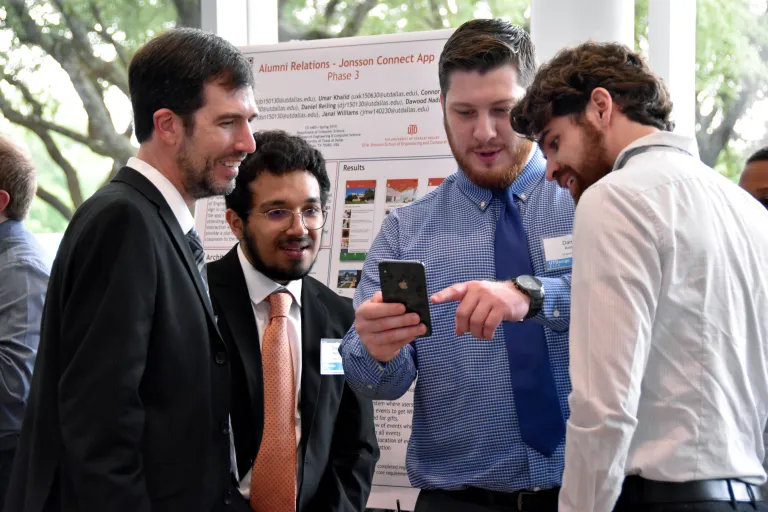
The final results of the projects created by CS/SE seniors in Erik Jonsson School of Engineering and Computer Science ranged from a Projectile Evasion System for Unmanned Vehicles which recognizes, evaluates and responds to foreign projectiles according to the threat risk, to an standalone iOS application that finds a beaconless solution to collect auto telematics data and associating trip data with vehicles under the insurance policy, an app that works to extract text from scanned letters, categorize any medical information, and export the data, and even a AI Meme Generator that focuses on improving various artificial intelligence concepts such as optical character recognition, text generation, and emotion recognition to successfully create an advice animal meme, and virtual reality platform for immersive and accessible police training. Other projects may improve the UT Dallas experience, including the new Jonsson Connect app, which keeps UT Dallas Jonsson School alumni up to date on UT Dallas News and events, and various other apps that benefit the UTDesign studios. Many of the projects utilized multiple fields of computer science and software engineering such as Artificial Intelligence, Machine Learning, Natural Language Processing, Blockchain, Data Analytics, etc.
The teams and projects are sponsored by both large-scale companies as well as UT Dallas faculty members’ research labs and are judged at the end of the semester at the UTDesign Expo. UTDesign helps businesses enhance their technical base by leveraging the skills, energy, and zeal of talented computer science and engineering students. Companies who work with students in the UTDesign program benefit from the knowledge gained from the students who are currently being taught the latest in cutting-edge innovations in their field within the UT Dallas CS program.

Among the corporate sponsors in this year’s spring expo were Aprima Medical Software, Atos, CitiGroup, Collins Aerospace, CoreLogic, IDEXX, IntelliChoice, SignaPay, State Farm, Raytheon, Texas Instruments, ThreadAI, Tyler Technologies, Walmart, Immosis LLC, UT Dallas, and many more. Many of these companies have used the code that students developed and have put it into production within their respective companies. The capstone project course is taught by Dr. Miguel Razo, who is also the CS UTDesign program director. Dr. Razo is assisted by the UT Design Staff led by Assistant Dean Mr. Rod Wetterskog.
Companies are not the only ones who benefit from the program, as students working on the projects are eager to find solutions for sponsoring companies’ projects by offering innovative ideas, forward-thinking approaches to solving problems, and bold and creative solutions. The UTDesign program allows students to fully engage in the design process and use their project-management and problem-solving skills while working on projects applicable to a company, consumer, or faculty member’s research. As part of the course, students also learned about entrepreneurship, including four lectures that were delivered by the UT Dallas Institute for Innovation and Entrepreneurship (IIE), in conjunction with lectures given by UT Dallas CS faculty members focusing on leadership and software project management.
On the day of the expo, the 52 teams were split into three rooms for presentations. Each team was allowed to use only one slide to present their work. Brevity was critical in covering the goal of the project, design of the project, project testing, validation plan, results achieved, project management approach, and acknowledgment of sponsors – all within their allotted five minutes. Projects were judged by the quality of technical content within the presentation – problem description, design approach, and implementation as well as oral and visual presentation skills. The projects were also judged on how effectively the presenters used their five minutes to understand/explain the social impact of the project, and their ability to explain the process followed for the project with support from related documentation. Finally, the projects were also judged on the quality of the technical content in the associated poster.
The following were the top three winners as well as the honorable mention winners:
1st Place – State Farm – Drivelytics v2.0 – Team A
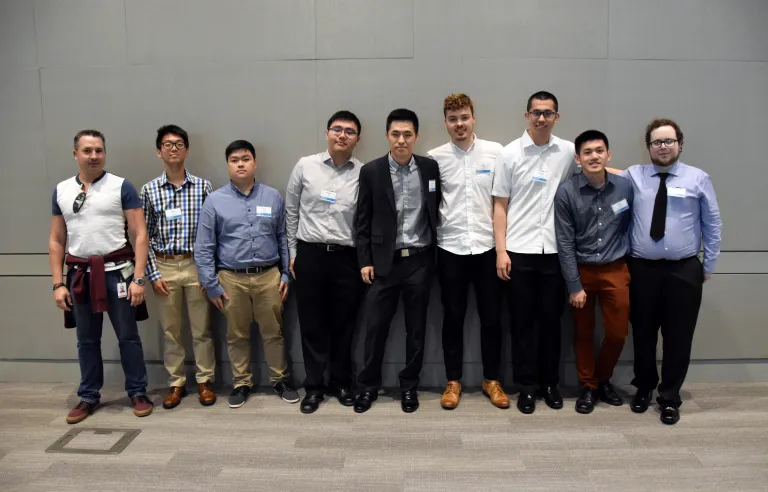
Authors: (from the left) Steven Kirtzic (State Farm Corporate Mentor), Victor Mao, Hoang Dang, Edward Yang, Yuncheng Gao, Einar Longva, Zongzhe Li, Tran Nguyen, Dalton Sherer
Abstract: The project goal was to enhance Drivelytics 1.0 app from the Fall 2018 semester. The Drivelytics 2.0 app features an enhanced scoring algorithm, a new acceleration detection method, and detailed data upload. Enhancements also included new distracted driving detection methods, and weather parameters used to score the user’s driving habits. The enhanced scoring algorithm factors in weather, sound, phone tilt, keyboard usage and parameters such as speeding, construction, and traffic from Team B. Extra features implemented are weather widget, trip rating, safe driving video, and sweepstake entry.
2nd Place – Raytheon – Projectile Evasion System for Unmanned Vehicles
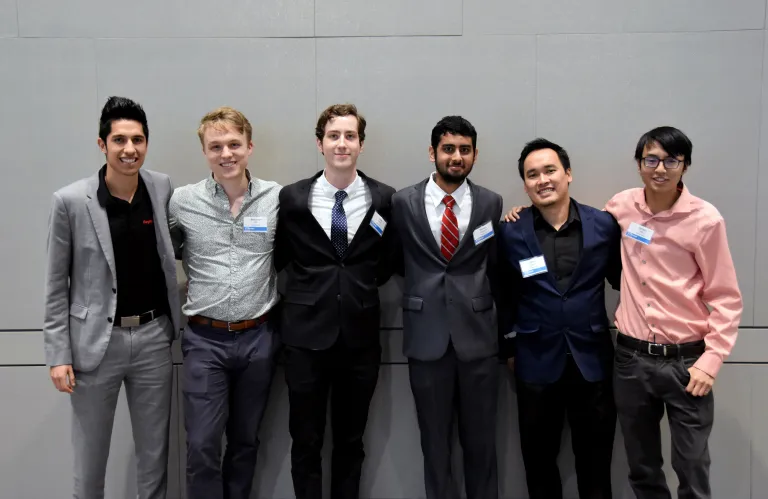
Authors: (from the left) Alfonso Lopez (Raytheon Corporate Mentor), Benjamin Hill, Noah Glenn, Naman Gangwani, Jimmy Nguyen, Ethan Tran
Abstract: Projectile Evasion is a system that recognizes, evaluates, and responds to foreign projectiles according to the threat risk. The purpose of this project was to create a plug-and-play style framework encompassing different avoidance technologies and algorithms in order to protect the unmanned system from attacks. For this semester, a machine learning and a color-detecting camera were used to detect projectiles using the principles of computer vision. These details are passed to the onboard processor, which evaluates the risk and takes the necessary evasive action. The onboard processor also acts as a ‘flight controller’ to control the movements of the unmanned system in real-time. By developing such smart technology, which aids in autopilot flight, self-correction, and active obstacle avoidance, drones can gain the ability to maneuver into unfamiliar territory with the comfort of knowing that any foreign object can be recognized and avoided. The framework provides a means of adding new features and defense mechanisms via modules.
3rd Place – Aprima – Aprima Comprehend
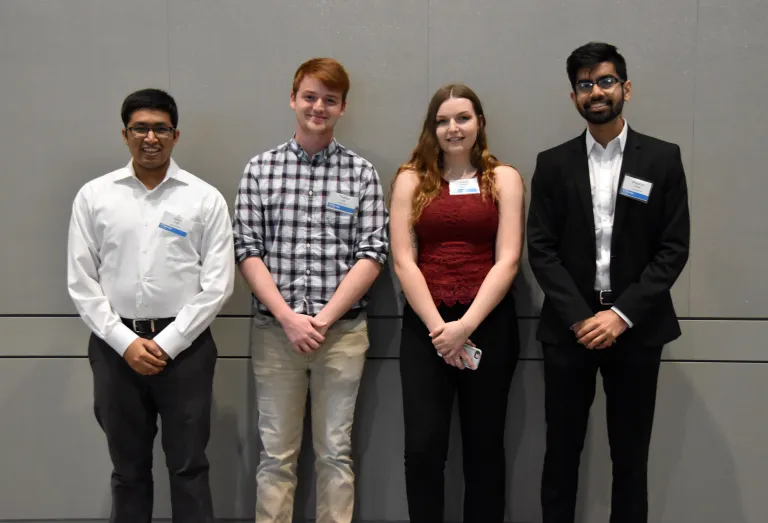
Authors: (from the left) Kevin Shah, Thomas Self, Haylee Noonan, Divyansh Prasad
Abstract: Medical offices get hundreds of letters and documents every day that need to be scanned and added to patient’s medical records. This process is time-consuming because the medical staff has to upload the scanned document and manually search for the patient in the database to add it to their file. In most cases, the information in the document doesn’t even get added to the patient’s records.
In order to expedite this process, Aprima Comprehend extracts text from scanned letters, categorizes any medical information, and exports the data in one seamless application. With the use of Optical Character Recognition through AWS Textract and Natural Language Processing through AWS Comprehend Medical, the efficiency of medical offices will be increased.
4th Place (Honorable Mention) – Atos – AI Meme Generator
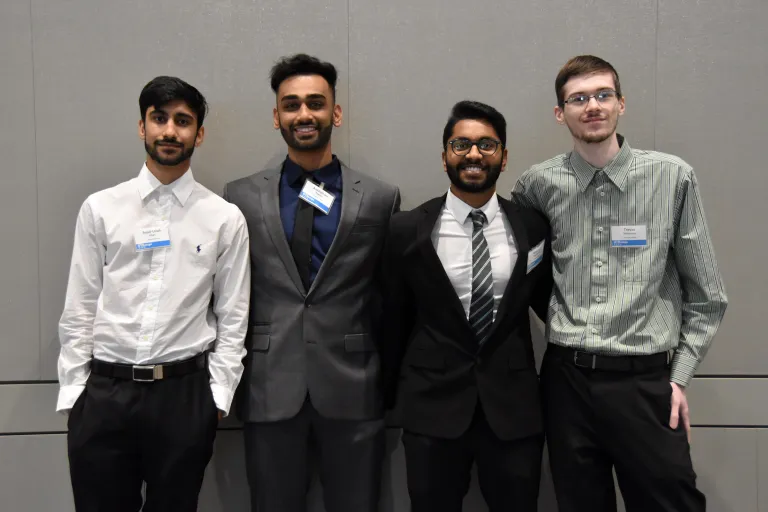
Authors: (from the left) Asad-Ullah Khan, Anshuman Pandey, Nagendra Singirikonda, Trevor Whitmore
Abstract: In order to enhance communication and marketing resources, the AI Meme Generator uses a smart meme generator to apply current trends to generate new material. This project focused on improving various artificial intelligence concepts such as optical character recognition, text generation, and emotion recognition to successfully create an advice animal meme. Phase 1 of this project included database design to store image characteristics as well as web development for a user interface to communicate with the application and the database.
5th Place (Honorable Mention) – CERES Technologies – Smart Supply-Chain Tracking
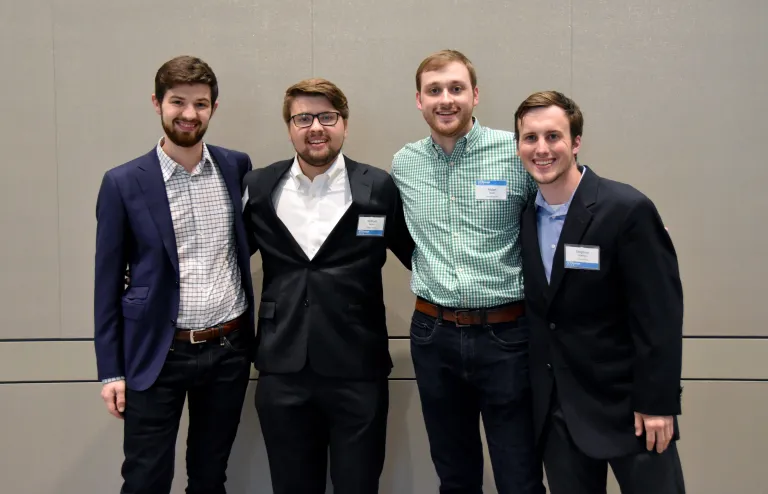
Authors: (from the left) Priyanka Daryani (not pictured), Michael Lewellen, William Meyer, Aidan Noel, Stephen Harlow, Jacob Cherry (not pictured), Ryan Lira (not pictured)
Abstract: CERES supports any commercially available set of IoT hardware sensors to track the environmental and physical conditions (such as temperature, humidity, etc.) of perishable products along any given supply chain in near real-time and connects to a smart contract using blockchain. The main challenge was to create an entirely new and efficient cloud-based big data system that can receive IoT data, store it in a database, perform blockchain verification and other data analytics using machine learning principles, if required. The project successfully implemented the solution by creating a smart supply-chain contract system complete with IoT data collection/analytics, and a model customer dashboard using basic web development.
Click here to see all the photos from the Spring 2019 UTDesign CS Expo
ABOUT THE UT DALLAS COMPUTER SCIENCE DEPARTMENT
The UT Dallas Computer Science program is one of the largest Computer Science departments in the United States with over 2,800 bachelors-degree students, more than 1,000 master’s students, 190 Ph.D. students, 52 tenure-track faculty members, and 41 full-time senior lecturers, as of Fall 2018. With The University of Texas at Dallas’ unique history of starting as a graduate institution first, the CS Department is built on a legacy of valuing innovative research and providing advanced training for software engineers and computer scientists.




